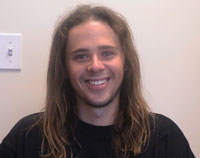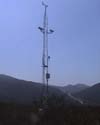Alex Revchuk Wins Undergraduate Fellowship Prize
|
10.15.02 - "We're trying to measure a range of weather and hydrological fluctuations in real time using a tight array over a coastal watershed," begins Alex Revchuk. "Southern California's Mediterranean climate has a lot of texture due to the region's complex topography. If we can understand weather at this 'micro' level, we're hoping to begin understanding how the fluctuations work together to cause major changes in the climate." [View Power Point Presentation]
Not exactly an unambitious research project. Especially for an undergraduate student who has other things to worry about, like classes and exams. Not to mention his own rock band "Downpour" that performs professional gigs at clubs around San Diego, including UCSD's own Porter's Pub, and has recorded a five-song, extended play CD expected to be released in a month.
But because of the project's broadly interdisciplinary nature, it caught Revchuk's attention. His work was so outstanding that it, in turn, caught the attention of the UCSD layer leaders who recently awarded him the Calit² Undergraduate Research Fellowship Prize. What made his work stand out were the interdisciplinary nature of his research blending sensors, wireless, and ecology, the results achieved, and the professional look and, in the words of one layer leader, the "sheer beauty" of his poster. The prize itself is a PDA of Revchuk's choosing with a wireless card.
By micro climate, Revchuk means on a scale of hundreds of meters.
|
"We've been installing 10-meter-tall towers in the Santa Margarita Ecological Reserve near Fallbrook," he explains. "These towers are being outfitted with like configurations of sensors so we can calibrate the towers and the data readings they produce." This sensor input will provide a level of resolution in the data not possible from satellite imagery. SMER is managed by the San Diego State University (SDSU) Field Station Program directed by Sedra Shapiro. Revchuk delivered his research results, as did other Calit² summer fellows, on Sept. 23; to view that presentation in streaming video, click in the box at right.
To study weather on such a detailed scale, numerous sensors and instruments are needed. They need to be small, inexpensive, and easily maintainable, and include thermometers, anemometers (to measure wind velocity, direction, and force), barometric pressure sensors, tipping rain buckets (precipitation), pyranometers (incoming radiation), and fuel moisture sensors (aridness of vegetation).
The underlying telecommunications infrastructure is provided by the High Performance Wireless Research and Education Network, the 45-megabit-per-second wireless network reaching many, including remote, parts of San Diego County. HPWREN is the brainchild of network researcher Hans-Werner Braun, San Diego Supercomputer Center, and seismologist Frank Vernon, Scripps Institution of Oceanography.
One of 22 summer undergraduate student research fellows (out of more than 80 that applied for the program), Revchuk has been working under the direction of Dan Cayan, researcher and director of the Climate Research Division at the Scripps Institution of Oceanography (SIO).
"We're also interested in water quality issues," says Revchuk. "So some of the towers are being positioned close to the Santa Margarita River to test, for example, for pollutants from agricultural runoff produced upstream."
Revchuk is majoring in Environmental Systems. "I started out majoring in Electrical and Computer Engineering," he says, "but I changed because I found it too narrowly focused on engineering." He sounds like someone arrived on campus already suffused with the spirit of Calit².
"I've been interested in communications since about the age of 13," says Revchuk. "I've built radios and antennas - all sorts of things. But I typically worked on my own." What he points to as the value for him from the fellowship program is his experience working in a team and communicating with people with diverse backgrounds and expertise. "It's been very intellectually stimulating," he says.
Now a junior, Revchuk envisions his senior project will be to work out a scheme to optimize the communications coverage and meteorological sampling over the complex topography of the Santa Margarita River in a possible extension of the HPWREN infrastructure westward through Camp Pendleton, the U.S. Marine Corps base to the west of SMER.
"The challenge will be to select the right locations for network access points, ensuring line of sight between towers," he says. "When line of sight is not possible, we're likely to use microwave reflectors to bounce the microwave signals between antennas." This extension will enable an even more comprehensive picture of the climate of southern California.
Born in Kiev and a native speaker of Ukrainian and fluent in Russian, Revchuk is interested in integrating perspectives from diverse "cultures." But he extends the meaning of "cultures" to mean not only different linguistic groups but different disciplinary groups, such as the different cultures of network researchers and applications researchers he's working with on his project.
"What's so interesting about this," he says, "is that I'm learning different 'languages' from the two groups." He takes the language analogy one step further by mentioning the need for "translation." But, in this context, he's pointing to his longer-term interest in translating science and technology into policy.
"What I'd ultimately like to do," says Revchuk, "is become a field researcher. I like being a techie - but I've got to do it outside."
Revchuk particularly thanks Cayan, Braun, Todd Hansen, a technical member of Braun's team, and Pablo Bryant, a technical specialist from the SDSU Field Station Program.
Media Contacts
Related Links
Biography
Video Presentation
Environment and Civil Infrastructure Layer
HPWREN



